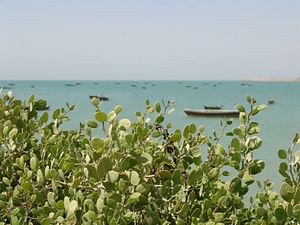Pakistan has been facing the brunt of climate change for quite some time. Over the past 50 years, the annual mean temperature in Pakistan has already increased by roughly 0.5 degrees Celsius.
In 2017, a German think tank ranked Pakistan as the seventh most vulnerable country to climate change in the world. In addition, according to the think tank’s estimate, between 1997 and 2016, Pakistan lost an average of 523.1 lives per year due to extreme environmental and weather conditions. A growing number of analysts consider climate change a major security threat multiplier in the country.
But rising temperatures are not the only manmade environmental conditions impacting Pakistan and the rest of the world, explains Sidra Adil, an environmental engineer and GIS analyst.
“The impacts of climate change in Pakistan is somewhat finally becoming an issue that is being discussed on national levels but the impacts of biodiversity loss are yet to become mainstream [knowledge],” says Adil. “The depletion of natural habitats in the country are creating significant problems already and will worsen in the long run.”
Adil is attending a UN meeting to discuss protection of natural habitats and resources currently taking place in Egypt. The meeting is being attended by representatives from 196 states, including Pakistan. In the next two years, the UN Convention on Biodiversity (UN CBD), aims to define a post-2020 global framework on biodiversity to be adopted in Beijing, China in 2020 — much as the Paris Agreement did in 2015 for climate change.
Pakistan has framed a biodiversity conservation and protection plan aimed at stemming biodiversity loss, restoring ecosystems and promoting sustainable use of natural resources.
Currently, Pakistan has some 28.5 million hectares of rangelands that are under threat of severe degradation.
“The principal cause of degradation is the rapidly increasing domestic livestock population, which is continuing to increase at a rate of two percent per year,” says Adil. Forests are cleared up for land for livestock grazing as well as to grow forage.
“Forests in northern Pakistan are rapidly diminishing because of deforestation while coastal areas, which have had rich reserves of mangrove forests, are also quickly disappearing,” she adds.
Pakistan, a semi-arid country, possesses only 5 percent of its area as forests, and that figure is rapidly declining. Increasing rates of consumption of fuel wood and timber as well as the requirement for land for domestic livestock are the principal causes of this depletion.
Mangrove forests in Pakistan’s coastal provinces extend over 132,000 hectares and represent about 3 percent of the country’s forest area.
“These forests play a significant role in protecting ports from floods and also provide breeding grounds for many fish, which has commercial importance,” explains Adil. “But they are being over-harvested and it is one of the most urgent issues that needs to be addressed to protect the country’s biodiversity.”
Pakistan’s National Biodiversity Strategy and Action Plan (NBSAP), made by the Pakistani Ministry of Climate Change’s forestry wing in collaboration with the International Union for Conservation of Nature (IUCN) and the country’s provincial forest, water, environment and wildlife experts, was approved in 2015 and is currently in the process of implementation.
Environmental protection and conservation as well as the sustainable use of natural resources and protection of wildlife are outlined as key goals while the plan also addresses tackling the underlying causes of biodiversity loss by mainstreaming the issue across government and society in general.
“We must cut the direct pressure on biodiversity and promote sustainable uses. The loss of biodiversity has been speeding up at a very high rate and all provincial forests and wildlife departments must come together to fix it,” states a spokesperson for the ministry. “But we also need to create more awareness amongst people about the issue because it cannot be solved without engaging with individual citizens.”
While climate change and its impacts have been picking up the attention of both policymakers and the media, the impacts of biodiversity loss still remain largely underdiscussed.
“What is necessary at present is to engage local communities (both urban and rural) to understand both climate change and biodiversity loss to create solutions using citizen and civic movements,” says F. Fasih. Fasih is a program manager for sustainable development at the Center of Excellence in Responsible Business (CERB) and follows up on the private sector’s track record in the UN Sustainable Development Goals (SDGs) in Pakistan.
“Just take the ongoing UN conference on biodiversity — there has been little to no local media coverage on how the ongoing negotiations will impact Pakistan,” she adds. “Biodiversity conservation policies must prioritize increasing awareness amongst the citizens because very little difference can be made by projects that require billions of dollars in funding.”
Rabiya Jaffery is a freelance journalist and multimedia producer based in the Middle East. She reports on sustainability, human rights, culture, and politics for a variety of local and regional publications. She tweets at @rabiyasdfghjkl.

































